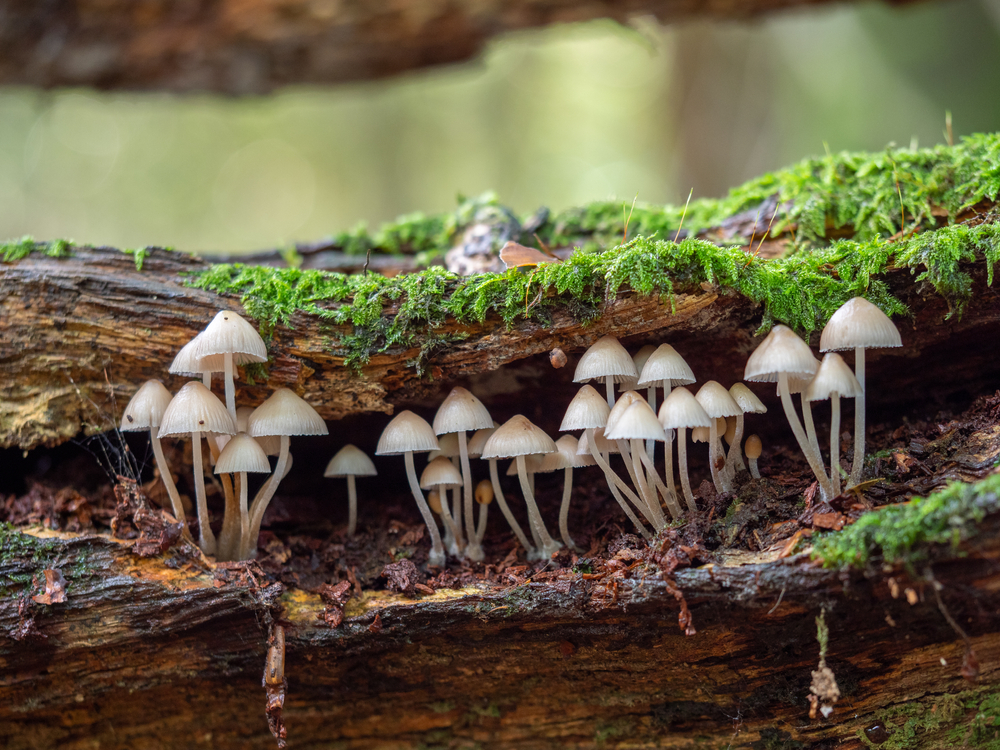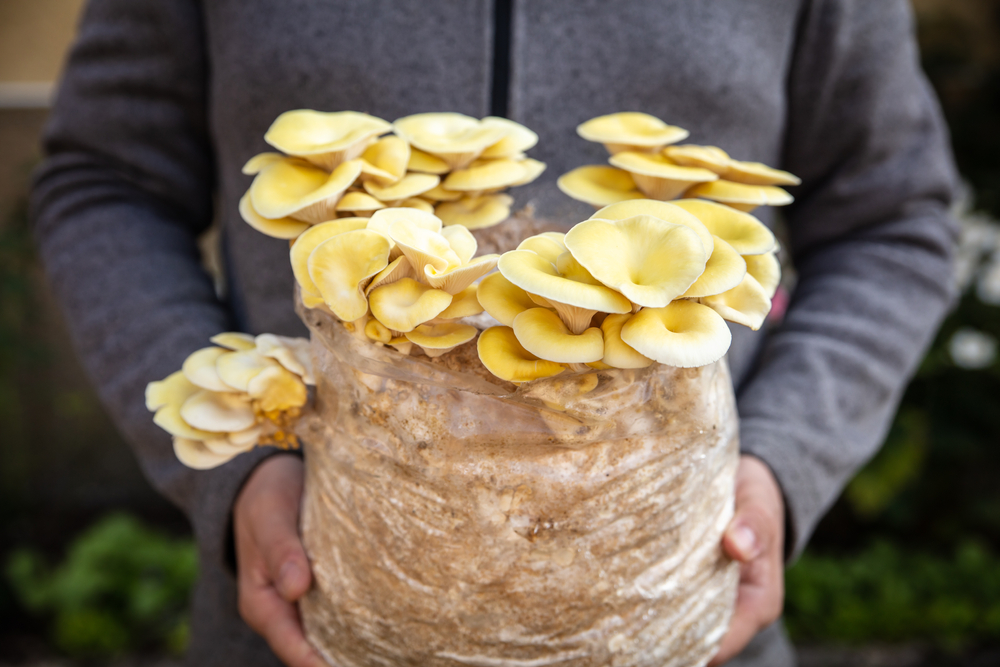Opinion: It’s Time to Include Fungi in Conservation Goals
Without fungi, life on Earth would be unrecognizable. So why aren’t they catalogued and understood as much as animals and plants?
Opinion: It’s Time to Include Fungi in Conservation Goals
Without fungi, life on Earth would be unrecognizable. So why aren’t they catalogued and understood as much as animals and plants?

Decomposers at work.by Stephan Morris, Shutterstock.
This article is republished from The Conversation under a Creative Commons license. Read the original article.
It’s no secret that Earth’s biodiversity is at risk. According to the International Union for the Conservation of Nature, 26 percent of all mammals, 14 percent of birds and 41 percent of amphibians are currently threatened worldwide, mainly due to human impacts such as climate change and development.
Other forms of life are also under pressure, but they are harder to count and assess. Some scientists have warned of mass insect die-offs, although others say the case hasn’t been proved. And then there are fungi—microbes that often go unnoticed, with an estimated 2 million to 4 million species. Fewer than 150,000 fungi have received formal scientific descriptions and classifications.
If you enjoy bread, wine or soy sauce, or have taken penicillin or immunosuppressant drugs, thank fungi, which make all of these products possible. Except for baker’s yeast and button mushrooms, most fungi remain overlooked and thrive hidden in the dark and damp. But scientists agree that they are valuable organisms worth protecting.
As mycologists whose biodiversity work includes studying fungi that interact with millipedes, plants, mosquitoes and true bugs, we have devoted our careers to understanding the critical roles fungi play. These relationships can be beneficial, harmful or neutral for the fungus’s partner organism. But it’s not an overstatement to say that without fungi breaking down dead matter and recycling its nutrients, life on Earth would be unrecognizable.

Healthy ecosystems need fungi
The amazing biological fungal kingdom includes everything from bracket fungi, molds and yeasts to mushrooms and more. Fungi are not plants, although they’re usually stocked near fresh produce in grocery stores. In fact, they’re more closely related to animals.
But fungi have some unique features that set them apart. They grow by budding or as long, often branching, threadlike tubes. To reproduce, fungi typically form spores, a stage for spreading and dormancy. Rather than taking food into their bodies to eat, fungi release enzymes onto their food to break it down and then absorb sugars that are released. The fungal kingdom is very diverse, so many fungi break the mold.
Fungi play essential ecological roles worldwide. Some have been forming critical partnerships with plant roots for hundreds of millions of years. Others break down dead plants and animals and return key nutrients to the soil so other life forms can use them.
Fungi are among the few organisms that can degrade lignin, a main component of wood that gives plants their rigidity. Without fungi, our forests would be littered with huge piles of woody debris.
Still other fungi form unique mutualistic partnerships with insects. Flavodon ambrosius, a white rot decay fungus, not only serves as the primary source of nutrition for certain fungus-farming ambrosia beetles, but it also quickly out-competes other wood-colonizing fungi, which allows these beetles to build large, multigenerational communities. Similarly, leaf-cutter ants raise Leucoagaricus gongylophorus as food by gathering dead plant matter in their nests to feed their fungus partner.
A mostly unknown kingdom
We can only partially appreciate the benefits fungi provide, since scientists have a narrow and very incomplete view of the fungal kingdom. Imagine trying to assemble a 4-million-piece jigsaw puzzle with only 3 to 5 percent of the pieces. Mycologists struggle to formally describe Earth’s fungal biodiversity while simultaneously assessing various species’ conservation status and tracking losses.
The International Union for Conservation of Nature’s Red List of Threatened Species currently includes 551 fungi, compared to 58,343 plants and 12,100 insects. About 60 percent of these listed fungal species are gilled mushrooms or lichenized fungi, which represent a very narrow sampling of the fungal kingdom.
Asked what a fungus looks like, the average person will probably imagine a mushroom, which is partly correct. Mushrooms are “fruiting bodies,” or reproductive structures, that only certain fungi produce. But a majority of fungi don’t produce fruiting bodies that are visible to the eye, or any at all, so these “microfungi” go largely overlooked.
Many people see fungi as frightening or disgusting. Today, although positive interest in fungi is growing, species that cause diseases—such as chytrid fungus in amphibians and white-nose syndrome in bats—still receive more attention than fungi playing essential, beneficial roles in the environment.

Protecting our fungal future
Even with limited knowledge about the status of fungi, there is increasing evidence that climate change threatens them as much as it threatens plants, animals and other microbes. Pollution, drought, fire and other disturbances all are contributing to losses of precious fungi.
This isn’t just true on land. Recent studies of aquatic fungi, which play all kinds of important roles in rivers, lakes and oceans, have raised concerns that little is being done to conserve them.
It is hard to motivate people to care about something they do not know about or understand. And it’s difficult to establish effective conservation programs for organisms that are mysterious even to scientists. But people who care about fungi are trying. In addition to the IUCN Fungal Conservation Committee, which coordinates global fungal conservation initiatives, various nongovernment organizations and nonprofits advocate for fungi.
Over the past two years, we have seen a surge of public interest in all things fungal, from home grow kits and cultivation courses to increased enrollment in local mycological societies. We hope this newfound acceptance can benefit fungi, their habitats and people who study and steward them. One measure of success would be for people to ask not just whether a mushroom is poisonous or edible, but also whether it needs protection.
Delegations from most of the world’s countries will meet in China this fall for a major conference on protecting biodiversity. Their goal is to set international benchmarks for conserving life on Earth for years to come. Mycologists want the plan to include mushrooms, yeasts and molds.
Anyone who takes their curiosity outdoors can use community science platforms, such as iNaturalist, to report their observations of fungi and learn more. Joining a mycology club is a great way to learn how to find and harvest fungi responsibly, without overpicking or damaging their habitats.
Fungi are forming important networks and partnerships all around us in the environment, moving resources and information in all directions between soil, water and other living things. To us, they exemplify the power of connection and cooperation—valuable traits in this precarious phase of life on Earth.
Matt Kasson is an associate professor of mycology and plant pathology at West Virginia University; Brian Lovett is a postdoctoral researcher at West Virginia University; and Patricia Kaishian is a visiting assisting professor of biology at Bard College.
Follow us
This work is licensed under a Creative Commons Attribution-NoDerivatives 4.0 International License.
Want to republish a Modern Farmer story?
We are happy for Modern Farmer stories to be shared, and encourage you to republish our articles for your audience. When doing so, we ask that you follow these guidelines:
Please credit us and our writers
For the author byline, please use “Author Name, Modern Farmer.” At the top of our stories, if on the web, please include this text and link: “This story was originally published by Modern Farmer.”
Please make sure to include a link back to either our home page or the article URL.
At the bottom of the story, please include the following text:
“Modern Farmer is a nonprofit initiative dedicated to raising awareness and catalyzing action at the intersection of food, agriculture, and society. Read more at <link>Modern Farmer</link>.”
Use our widget
We’d like to be able to track our stories, so we ask that if you republish our content, you do so using our widget (located on the left hand side of the article). The HTML code has a built-in tracker that tells us the data and domain where the story was published, as well as view counts.
Check the image requirements
It’s your responsibility to confirm you're licensed to republish images in our articles. Some images, such as those from commercial providers, don't allow their images to be republished without permission or payment. Copyright terms are generally listed in the image caption and attribution. You are welcome to omit our images or substitute with your own. Charts and interactive graphics follow the same rules.
Don’t change too much. Or, ask us first.
Articles must be republished in their entirety. It’s okay to change references to time (“today” to “yesterday”) or location (“Iowa City, IA” to “here”). But please keep everything else the same.
If you feel strongly that a more material edit needs to be made, get in touch with us at [email protected]. We’re happy to discuss it with the original author, but we must have prior approval for changes before publication.
Special cases
Extracts. You may run the first few lines or paragraphs of the article and then say: “Read the full article at Modern Farmer” with a link back to the original article.
Quotes. You may quote authors provided you include a link back to the article URL.
Translations. These require writer approval. To inquire about translation of a Modern Farmer article, contact us at [email protected]
Signed consent / copyright release forms. These are not required, provided you are following these guidelines.
Print. Articles can be republished in print under these same rules, with the exception that you do not need to include the links.
Tag us
When sharing the story on social media, please tag us using the following: - Twitter (@ModFarm) - Facebook (@ModernFarmerMedia) - Instagram (@modfarm)
Use our content respectfully
Modern Farmer is a nonprofit and as such we share our content for free and in good faith in order to reach new audiences. Respectfully,
No selling ads against our stories. It’s okay to put our stories on pages with ads.
Don’t republish our material wholesale, or automatically; you need to select stories to be republished individually.
You have no rights to sell, license, syndicate, or otherwise represent yourself as the authorized owner of our material to any third parties. This means that you cannot actively publish or submit our work for syndication to third party platforms or apps like Apple News or Google News. We understand that publishers cannot fully control when certain third parties automatically summarize or crawl content from publishers’ own sites.
Keep in touch
We want to hear from you if you love Modern Farmer content, have a collaboration idea, or anything else to share. As a nonprofit outlet, we work in service of our community and are always open to comments, feedback, and ideas. Contact us at [email protected].by Matt Kasson, Brian Lovett and Patricia Kaishian, Modern Farmer
June 5, 2022
Modern Farmer Weekly
Solutions Hub
Innovations, ideas and inspiration. Actionable solutions for a resilient food system.
ExploreExplore other topics
Share With Us
We want to hear from Modern Farmer readers who have thoughtful commentary, actionable solutions, or helpful ideas to share.
SubmitNecessary cookies are absolutely essential for the website to function properly. This category only includes cookies that ensures basic functionalities and security features of the website. These cookies do not store any personal information.
Any cookies that may not be particularly necessary for the website to function and are used specifically to collect user personal data via analytics, ads, other embedded contents are termed as non-necessary cookies.
Makes a lot of sense to me.
An excellent journey into regenerative agriculture by way of fungi > https://www.youtube.com/watch?v=aGiJt6e_gqQ